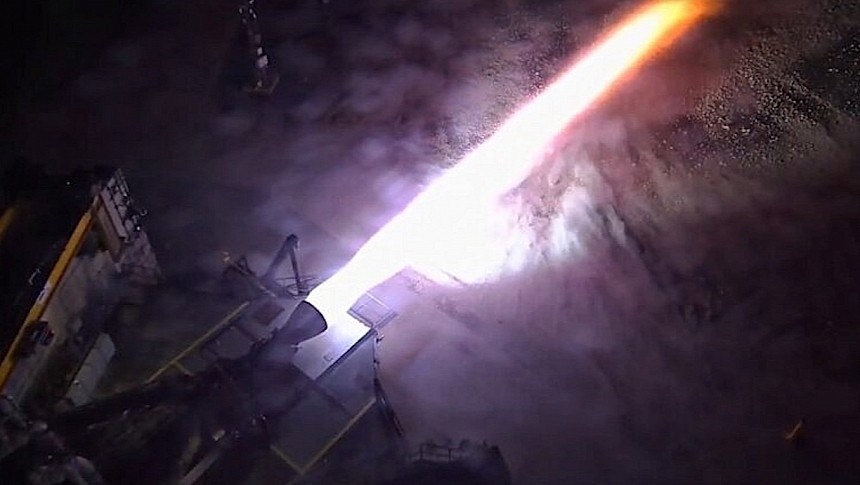The world is getting ready for next year's launch of the first crewed Artemis mission to the Moon. It's a limited-scope one, but if all goes well, it will open the doors later in 2025 to Artemis III, the flight that will place American boots on Luna once again.
The Artemis III mission is a collection of firsts, including a never-before-seen collaboration between NASA and private space companies like SpaceX. Elon Musk's side business is not only a partner in the mission, but it will also supply the vehicle that'll bring astronauts down from their spaceship to the surface of the Moon.
The tech is called Starship HLS (human landing system), and not much official info is known about it at the moment. Behind closed doors, both NASA and SpaceX are working on it, though, and the latest update has to do with the thing's engines.
When ready for flight, the HLS will be powered by two very different engines of the Raptor variety. Already in use in current SpaceX rockets and spaceships, the Raptors will have to be modified as follows: one to be able to sustain flight in atmospheric pressure at sea level, and the other suitable to operate in a vacuum.
It was this week when NASA made public the fact that in August SpaceX demonstrated the operation of the vacuum-ready Raptor as part of a test run. Unlike the previous test, which focused on whether the engine could land the Starship on the Moon, this one was meant to prove the Raptor can be started in extremely cold conditions.
That's because while in space en route to its destination, the Starship will have to spend a relatively long time turned off, and that will definitely make its temperature drop below what the Raptor engines usually have to deal with.
We're told the cold start test went as planned, and it confirmed the engine can be ignited after a long off time. No other details, however, are provided on what that means.
NASA and SpaceX will continue to put HLS-modified Raptors through their paces, with the following one being an integrated flight test on both the Starship and Super Heavy.
As for Artemis III, the mission will take a crew of four people to the Moon's South Pole, including "the first woman and first person of color on the surface of the Moon." The location for the mission was chosen because there’s a high likelihood of materials needed for future operations (including oxygen and water) to be found.
The Starship lander will serve both the Artemis III and the Artemis IV missions. From Artemis V onward, the hardware to be used will be made by Blue Origin. Jeff Bezos' company will have to have the machine ready by the end of the decade.
The tech is called Starship HLS (human landing system), and not much official info is known about it at the moment. Behind closed doors, both NASA and SpaceX are working on it, though, and the latest update has to do with the thing's engines.
When ready for flight, the HLS will be powered by two very different engines of the Raptor variety. Already in use in current SpaceX rockets and spaceships, the Raptors will have to be modified as follows: one to be able to sustain flight in atmospheric pressure at sea level, and the other suitable to operate in a vacuum.
It was this week when NASA made public the fact that in August SpaceX demonstrated the operation of the vacuum-ready Raptor as part of a test run. Unlike the previous test, which focused on whether the engine could land the Starship on the Moon, this one was meant to prove the Raptor can be started in extremely cold conditions.
That's because while in space en route to its destination, the Starship will have to spend a relatively long time turned off, and that will definitely make its temperature drop below what the Raptor engines usually have to deal with.
We're told the cold start test went as planned, and it confirmed the engine can be ignited after a long off time. No other details, however, are provided on what that means.
NASA and SpaceX will continue to put HLS-modified Raptors through their paces, with the following one being an integrated flight test on both the Starship and Super Heavy.
As for Artemis III, the mission will take a crew of four people to the Moon's South Pole, including "the first woman and first person of color on the surface of the Moon." The location for the mission was chosen because there’s a high likelihood of materials needed for future operations (including oxygen and water) to be found.
The Starship lander will serve both the Artemis III and the Artemis IV missions. From Artemis V onward, the hardware to be used will be made by Blue Origin. Jeff Bezos' company will have to have the machine ready by the end of the decade.
Moon soon https://t.co/bD3PQDv0gM
— Elon Musk (@elonmusk) September 14, 2023














